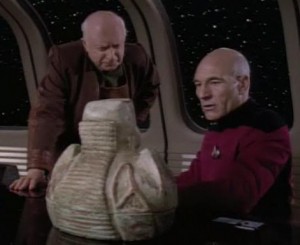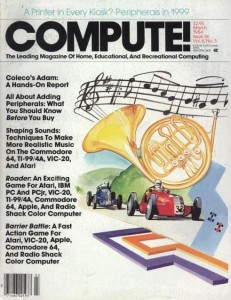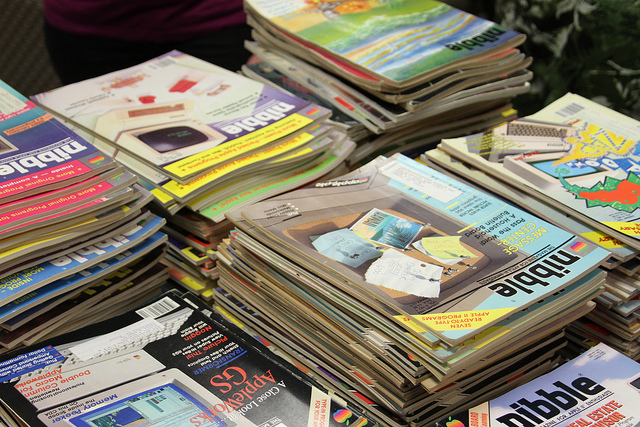After the Flood —
There’s good and bad in the Star Trek franchise, but certainly The Next Generation had some mighty subtle portrayals buried in among the episodes, especially as things got a bunch of seasons in. One that has always struck me, personally, is a short scene in the beginning of an episode called The Chase, where the captain’s old mentor in archaeology tries to convince him to take a leave of absence to go on a hunt for something or other; the rest of the episode concerns this, and isn’t relevant to what I’m saying. What is relevant is where he direct’s the captain’s attention to an artifact on the table and asks him to check it out.
I’m in no mood to discuss Star Trek canon, but just want to point out that Patrick Stewart, on the right, is an excellent actor. The scene called for him to be told that this artifact, rare enough as it is, was also intact, containing smaller statues inside and therefore unbelievably rare. To show his character reacting to this fact, Stewart put a lot into his performance – his incredulity that the statue was there at all, and then a wide-eyed releasing of breath to realize it’s complete, that he is holding in his hands one of the rarest (and most precious) things he could want to find, especially as an archaeologist. It is, like I said, remarkably subtle and way too subtle for what the scene calls for, which is mere motivation to later avenge the professor’s death and go on a chase through the galaxy.
But that feeling, of encountering something thought long gone and realizing you not only can see this thing that once was, but see it complete and whole is one of the strongest motivations I’ve had in the last 15 years of all this collecting materials of online life. I’ll see some site with a handful of badly scanned remembrances of something no longer active, and a few cramped words, and then we’re expected to be happy this is all there is left. Well, maybe we’re not happy and we wish there was so much more. And if I have to be the one to assemble the much more, so be it.
When I bring something online or assemble something from distant or obscure sources, I’m doing it for someone who is not me. I’m doing it for a person who has a whisper of a memory, be it a turn of phrase or a hacker’s handle or a BBS name or even some sort of image, like a toy robot or a smiling girl holding up some product in an ad. I want them to find, as easily as possible, that very thing, and get not just exactly what they sought, but to have the entire pantheon and context of what they were searching for.
So, remember Compute! magazine?
Boy, I sure do. Compute! was one of the biggies, one of the magazines you’d see down in the magazine rack at the bookstore and which was filled with bright, happy pages promising the world if you just typed in one of the programs, or which gave an optimistic outlook on how much wonderful stuff you could do with computers. If you subscribed to it (or merely bought every issue, like I tended to), then Compute! was a centerpiece of your computing experience at that time.
Well, here you go. Here’s every single issue of Compute! Magazine on archive.org.
Go ahead, browse around. You can open any issue, read it online, or download a PDF or kindle/e-reader-ready version, and look back on that awesome time, with breathless ads and helpful tips and ideas on what the next best thing was going to be, with the added advantage of knowing when they were right and wrong. Smile with knowing delight as someone predicts the future, and wince when they get so close but not close enough. The fact that nearly every person ended up becoming a self-contained GPS, communications and information hub wasn’t really on the horizon, so in many cases they’re amazingly off, assuming that machines would continue to be tethered to desks and the phone system would be a constant thorn in the side with its zone calls and strange mechanics.
You know, Compute! had a spin-off magazine? It was called the Compute! Gazette, and focused directly on Commodore machines. (Commodore 64, 128, Amiga, and so on.) It was also really well-put-together and some folks subscribed just to the Gazette if they were particularly Commodore-oriented. (Although most just ended up buying both magazines.)
Well, good news, because here’s every single issue of Compute! Gazette. Again, all browsable, all readable, all downloadable, every single issue. There were about ninety issues of Compute! Gazette, and something in the 170 issue range for Compute!, depending on how you count the specials and the one-off issues. Or maybe Atari computers were more your style, which is fine because here’s every issue of Antic Magazine, an Atari-oriented periodical, and there were eighty-five of them in all.
Gosh, well, maybe Ham Radio was more your deal, and just over this corner, we can see every single issue of Ham Radio Magazine, all two hundred and sixty-eight issues.
Go more obscure? Diehard, the Magazine for Commodore 8bitters was a mid 1990s phenomenon, all 23 issues there. If you weren’t a computer user in the UK, you probably never encountered the full run of Big K Magazine. I guess that’s about it… no, wait, here’s 85 issues of Your Commodore magazine, can’t forget that one.
Folks, I just dumped five hundred magazines into your lap.
Let’s be clear – I didn’t scan any of them; an army of volunteers, fans, historians and romantics did so, over a number of years. The indexing, generally, didn’t come from me (I did write some up), but came from sites such as atarimagazines.com that have been doing this whole “bringing in the magazines” thing for years before I focused on it. What’s different, mostly, is now these items are in a library, the archive.org archives, where they can be read and experienced in one place, in a uniform interface, although I will be the first to admit the interface can be much better at some of the other sites. I merely wrote scripts to ingest them into archive.org and did the occasional call for volunteers to help describe the issues without descriptions, a task that continues to the present.
I got these 500 magazines up in about 3 days. 72 hours. Imagine what things are going to be like by the end of the year. An exoskeleton, indeed.
Let’s step back, though, and this is what I actually want to talk about.
The often-automatic and frankly entirely valid question that comes from encountering, say, a 500-issue online stack of 1980s computer and technology magazines is “Why are you doing this? What purpose could this serve?” And my general answer has always been “Get the fuck out of the way, we’re losing precious items while we dawdle and diminish“, and while that is definitely still the case and my fight goes on to rescue lost data and artifacts, the question’s relevance and merit begins to leak into the margins of my work.
How much stuff is too much? I don’t have an answer for that and I don’t really see encountering “too much” in terms of acquisition, ever, where computer history is concerned. I’ve been in a room with basically every train set piece the Lionel Company ever made and that’s a lot of trains, folks, and I don’t see anything wrong with that. I don’t have an upper limit for the actual containing of items. But I do have concerns about the capacity of the potential audience to gain any amount of context or relevance onto the items.
So, being all Archive Team and stuff has gotten me running with a large social group of archivists, and that’s been a rather interesting experience. Archivists are not, professionally, a particularly bold bunch. Oh, off hours they are fucking insane but within the confines of the kinds of institutions that tend to hire archivists, being someone like, say, me, isn’t a recipe for long-range job security, so there’s a lot of contrast between my outlook/expressions and “the industry”. But often I’ve used different terms for things the “industry” has been dealing with for years, maybe decades, so forgive me if I keep doing that, forever, because I don’t tend to go to many archivist cons and I believe there’s something like a dozen librarian bloggers who would tie my shoelaces together if they saw me waiting near a train platform.
So like every industry, they have the usual things that linger in the background that drive everyone nuts but the solutions are rather difficult, and then there’s someone standing up one day going “pie is bad!” to much hmmmphing and rumbling, accompanied by “pie is good!” arguments and “why are you all arguing about pie” hand-wringing from the sidelines. Every group does this, there’s no shame in it. But the issues they discuss relevant to my growing pile of magazines and items are metadata and curation.
When John Flansburgh of They Might Be Giants worked in publishing (the basement of Conde’ Nast), he would often encounter strange images that then got incorporated into the band’s album artwork and flyers. To a Flansburgh, curation and metadata have no relevance – he would just go through everything as a matter of work, and then come in with “this is weird” and set it aside. Life provides a lot of opportunity for stumbling, endlessly. Nobody should be worried about the Flansburghs.
But if there’s someone who looks at a massive stack of magazines, online or off, and the question is “When did Synapse Software begin advertising in these issues and when did they stop, and what products did they advertise from their catalog?” then metadata becomes critical. Especially if the questions keep coming; a one-0ff crazy search is one thing (Pixar will do things like find every jailbreak scene, or every bank robbery scene, for reference material, from the corpus of known films), but if this is all you’re doing, all the time, then metadata is the difference between getting things done and focusing all your energy on convincing people with requests they don’t actually want to make that request, i.e. Asshole Librarian Approach.
Curation, the flip side, is presenting a smaller portion of an archive or container in such a way to focus on a subject and bring clarity to an audience or yourself – images of consumer-based robots, perhaps, or video games in which someone has been taken hostage. A curator wants metadata badly, but depending on the quality of the curation or its needs, they can get by with a minimal amount. The quality of the curator, by the way, leads to low-hanging fruit getting put out there (oh boy, another image of “Pac Man” to illustrate any sort of video game) while also bringing in a breathtaking amount of amazing work when done right, like Jambe Davdar’s beyond belief series on Star Wars, which is one of the most masterful commentary/annotations of a film series you will ever see. But the amount of work involved… well, that’s the secret pain of the curator.
Again, you’ve been handed 500 magazines. What’s your response? Do you smile, grab your iPad, find a quiet part of the house, and read? Or do you make a fist and pump it because you’re finally going to be able to type in that program way back when that you played as a kid? Or does just the fact that it exists comprise your entire interest in it, that you want to know that it’s out there, somewhere, being held “just in case”?
Or maybe you look at the pile and go “But we need to mark who wrote for what article! We need to list the companies in each issue! We need…” and what you do next tells me if you’re a complainer or a doer. I don’t have time for complainers, frankly. I’m too busy doing.
This flood is rising. It’s been around for a lot of other subjects and I’m going to help bring the flood to what we call “classic home computing”. Steady yourselves and decide what you’re going to be to it.
Categorised as: computer history
Comments are disabled on this post




Ha, I typed in Roader for the PCjr when my dad got our family that issue of Compute!. =)
I can’t recommend this site enough:
http://www.bombjack.org/commodore/
It _all_ needs to be on archive.org.
g.
Just dropped in to say I also typed in Roader from that Compute issue. I’m not sure how, but sometime around the early 90s I had many issues of Compute, Compute’s Gazette, and several other magazines. I don’t know what happened to them, they could still be at my mom’s for all I know. I’m glad you are out there doing this great work, Jason!
…by complete coincidence we just happened to watch that episode last night on Netflix, and I couldn’t help but notice the same things about Stewart’s performance. It just seemed so genuine, the way he lit up. His physicality and his vocal pacing and intonation were just letter perfect for the moment. I think the only episode of any Star Trek show that comes close to the same effect might be the one where Picard “lives” a second life in the memories of a long gone alien through a space probe (the one with the flute, referenced often in other episodes).
@Drew The episode you are referring to is called “The Inner Light”.
I’ll say it again, I wish whoever owns Ziff-Davis’ archives would make all past issues of PC Magazine (including its short lived spinoff PCjr Magazine) , PC/Computing, Windows Sources, and MacWorld available (I’m sure there are a few more obscure publications from ZD but those are the main ones).
Also of interest (and easy to archive) was the short lived PC Magazine “CD-ROM edition”. No, it wasn’t a PDF of the current month’s issues, but a unique interactive version complete with software demos and all the sample code from that month’s programming columns.
Holy! Crap! I am stunned beyond words. I used to wait eagerly for my copy of Compute! every month so I could type in those colossal machine language games which never worked…
Speaking of Commodore stuff, do you need INFO magazine, by any chance? I’ve got some of that.
Just read this and then read the post. Too relevant!
“[G]athering written and imaged resources in one place […] does not by itself guarantee any superiority for the one who gathers them. Why? Because the gatherer of such traces is immediately swamped in them. […] After a few years of collecting specimens with the Beagle, there were so many crates that Darwin was almost squeezed out of his house …” From Latour, “Drawing things together”, 1986.
Soon there’ll be a need for a Metadata Team!
I have fond memories of typing in listings for my TRS-80 from Softside Magazine, but I’ve been unable to find a good complete archive anywhere… Does anyone know of one?
Love the article, thanks!
There’s already a need for a metadata team! My “Metadata Warriors” group is actively transcribing metadata of all sorts of things going up. Want to join?
You had me at Antic….
Let’s not forget Ahoy! Magazine, another fine Commodore oriented publication..I remember purchasing a few of those at the local Douglas Drug way back in the early 80s
Added Ahoy! http://www.archive.org/details/ahoy-magazine
Re: Info 64… just saw archive.org. I guess you don’t need it now. 😀
Man, I loved that magazine. They actually laid out and printed the whole thing on the C64 (and Amiga later, but that’s not quite as much of a challenge really…)
I was never a Commodore person but I really appreciate what you do. If I didn’t have so much trouble focusing, I would be involved with the archive team. There’s so much to do, especially for someone like me who would see a stack of magazines on a curb and start reading.
Now I have ” Compute!” PDFs to add to my “Computer Gaming World” ones on my iPad 2 — suh-WEET!!!!!
And BTW, regarding your “Star Trek” reference — what always struck me was how powerful that scene is, but in “Star Trek: Generations”, when Picard is picking through the ruins of his office after the crash, he picks up that statue & tosses it aside as if to say: “Eh ….”.
When I saw that, I said: “Whoa! That’s his Professor Galen statue! He was so moved by it when he got it but now he’s just tossing it aside like it’s just one more piece o’ junk in his ruined office.”
Whatever ….
Thanks for all your hard work Jason. And you are right about Pat Stewart, he is a great actor!